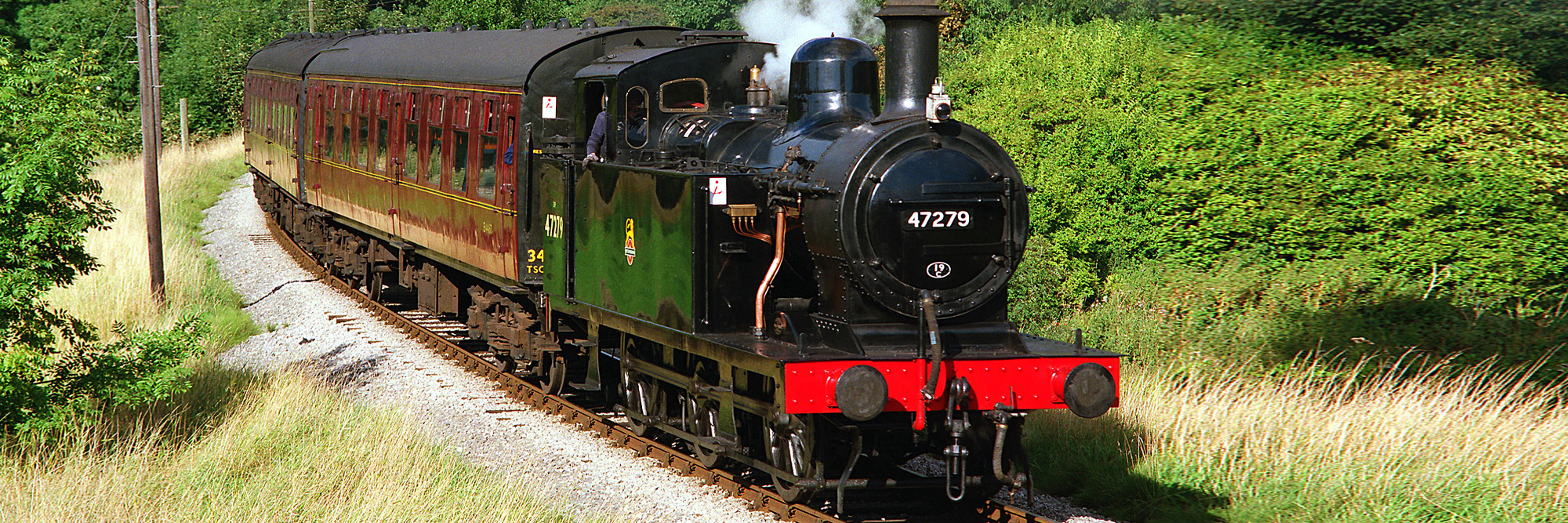A life shunting from Bedford in the south to Workington in the north
One of the first designs produced by the LMS, this useful 0-6-0 T, with origins dating back to the Midland Railway, were to be found all over the LMS system and lasted well into BR days.
A hard shunter’s life to the tranquillity of the Worth Valley
Completed in 1924, in LMS and, well into BR ownership, our ‘Jinty’ worked its entire life in the East Midlands shunting the yards at Nottingham, Wellingborough and Bedford before being exiled to the North West for its final move where it spent its last 4 years.
47279 was the 101st engine to be extricated from Barry although, by the time the South Yorkshire 3F Fund extracted it, it was little more than a shell, stripped, like many other engines, of any removable parts (even the chimney).
Data File
Built: 1924 Vulcan Foundry, Newton-le-Willows
Boiler Pressure: 160 psi
Tractive Effort: 20,830 lbf
Weight 49.5 tons
Valve Gear: Stephenson
Cylinders: 18″x26″ Inside
Numbers carried during working career: LMS 7119 & 7279, BR 47279
An unglamorous life
The 3F tanks are a direct development by the LMS of former Midland Railway 0-6-0 designs. They were built primarily for shunting duties but they also found employment on local freight workings and branch-line passenger duties (seven being fitted for push and pull working). Some of the Midland Railway designs actually saw service on passenger and freight services on the Worth Valley branch.
Introduced in 1924, a total of 422 were built between then and 1931 of which 407 were built by five outside manufacturers. No. 47279 was produced by the Vulcan Foundry at their Newton-le-Willows site in Lancashire in 1924 and was originally numbered 7119. It spent its early years shunting the vast marshalling yards at Toton in Nottinghamshire before being transferred to Nottingham Depot in May 1934. Also in 1934, the engine was renumbered 7279 by the LMS. The engine was then transferred in May 1938 to Wellingborough Shed where it remained (including time under British Railways after nationalisation) until 1957. In the August of that year, it moved to Bedford though it returned to Wellingborough shed for a brief spell in August 1963. The engine finally moved away from former Midland Railway territory in November 1963 when it transferred north to Workington where it found employment shunting the local coal mine sidings and also marshalling trains at the local steelworks in readiness for transhipment around the country. The engine was sent, in November 1965, to Aintree (Liverpool) and then moved again in November 1966 to Sutton Oak St. Helens) from where it was withdrawn from traffic and sold to the Woodham Bros. scrap-yard in South Wales in June 1967.
From a derelict shell to passenger duties
The engine was purchased by a private group (South Yorkshire 3F Fund) for use on the KWVR, arriving on the Railway in August 1979. After so many years languishing in the scrapyard it was hardly surprising that the engine, stripped down to a shell, was in an extremely derelict condition. Several appeals were made to other societies and private individuals through the railway press to try and locate suitable parts to aid the restoration of this engine. The appeal brought forth a replacement chimney which was being stored in an outside Iavatory awaiting eventual use as a flower pot!
The engine has been used for a wide variety of Worth Valley duties from passenger workings to use on works trains for the Civil Maintenance Department. However its 10 year boiler certificate expired in 2011 and 47279 now rests in Oxenhope Exhibition shed awaiting its turn in the restoration queue.
